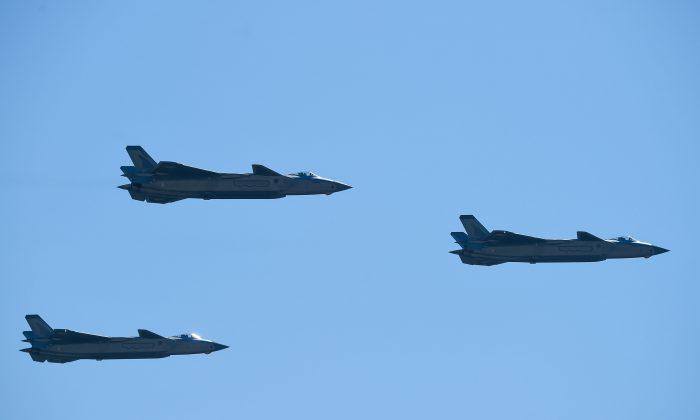News Analysis
The People’s Liberation Army Air Force (PLAAF)
executed a precision flyover of seven J-20 stealth fighter jets to announce that China is now mass-producing fifth-generation aircraft.
China Daily’s
promotional Sept. 4 video, featuring the J-20 aircraft cruising in formation, was meant to signal the rapid expansion of the PLAAF fleet.
Beijing-based military expert Zhou Chenming
told South China Morning Post that with China forecasting the United States and its allies to deploy 200 to 300 F-35 stealth fighters in the Asia-Pacific region by 2025, Beijing must respond in equal numbers.
Lockheed Martin, maker of the F-22 and F-35,
defined fifth-generation jet fighters as having all aspects of stealth when armed: low-probability-of-intercept radar; high-performance airframes; advanced avionics features; and highly integrated computer systems capable of networking with other battle space elements for situation awareness.
After investing at least $35 billion in top secret fifth-generation stealth development for 25 years, the United States introduced a prototype of the F-22 in 1997 and an F-35 advanced fighter in 2006. It took eight years of further development for the F-22 to enter active service in 2005, and another decade for the first F-35s to enter service in 2016.
Within a year of the F-35 prototype’s release, Chinese cyber-soldiers used malware to steal terabytes of data from Lockheed and its supply chain.
According to detailed documents released by former NSA analyst Edward Snowden after he fled to Russia to avoid prosecution, China in 2007 stole the stealthy radar design (the number and types of modules), detailed engine schematics (methods for cooling gases, leading and trailing edge treatments, and aft deck heating contour maps), and engine designs.
The U.S. F-35 after-action report
estimated that China hacked U.S. Department of Defense computers at least 30,000 times, penetrating more than 1,600 network computers, compromising 600,000 user accounts, and causing more than $100 million in response costs.
As later
disclosed in a 2018 federal plea bargain, China cyber-penetration schemes tend to involve PLA military officers sending phishing emails to individuals at the target companies, usually purporting to be a colleague or industry contact. Once the employee enters a website, malware is installed that gives Chinese agents remote access to directories that contain trade secrets and a worm to search the company’s network.
China unveiled prototypes for the Chengdu J-20 fighter in 2011 and advanced Shenyang FC-31 in 2012 as its first stealth aircraft. U.S. designs similarities included edge alignment and smooth surfaces; radar absorption coatings on plane surface and canopy; and a thick fuselage for an internally recessed weapons bay.
In what is considered an engineering feat, the J-20 officially entered PLA Air Force service in 2017, just six years after its initial prototype.
The most difficult aspect of building fighter jets is the precision manufacturing of its engines. The National Interest
reported earlier this year that China was experiencing difficulty with mass producing the J-20’s specially built WS-15 engine, because Chinese-built
single-crystal turbine engine blades couldn’t handle the combination of high temperatures and maneuvering stress needed to power J-20 airframes at up to Mach 2.
As a backstop in 2017, the PLAAF initially used its aging WS-10B engine that relied on the same core machine technology of CFM-56 aero engines that were imported from the United States in the 1980s. The WS-10B’s thrust-to-weight ratio is insufficient to power the
J-20 at supersonic speeds without using afterburners, which defeat its stealth capabilities.
Chriss Street is an expert in macroeconomics, technology, and national security. He has served as CEO of several companies and is an active writer with more than 1,500 publications. He also regularly provides strategy lectures to graduate students at top Southern California universities.






Friends Read Free